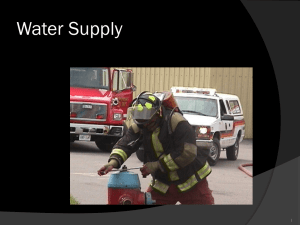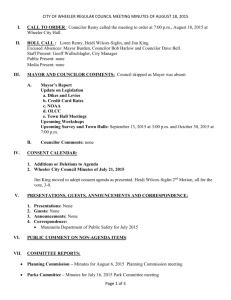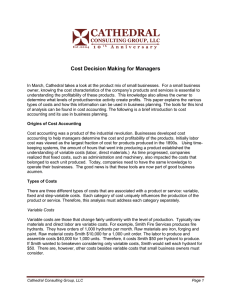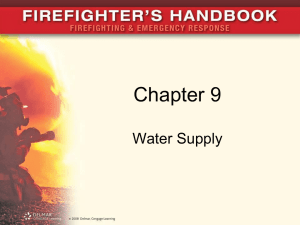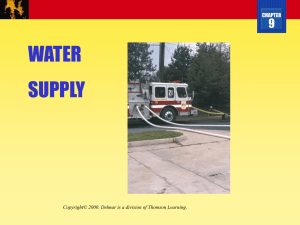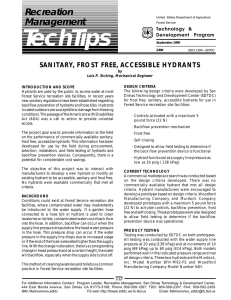Recreation Modifying Water Hydrant Handles To Make Them Safer Technology & Development
advertisement
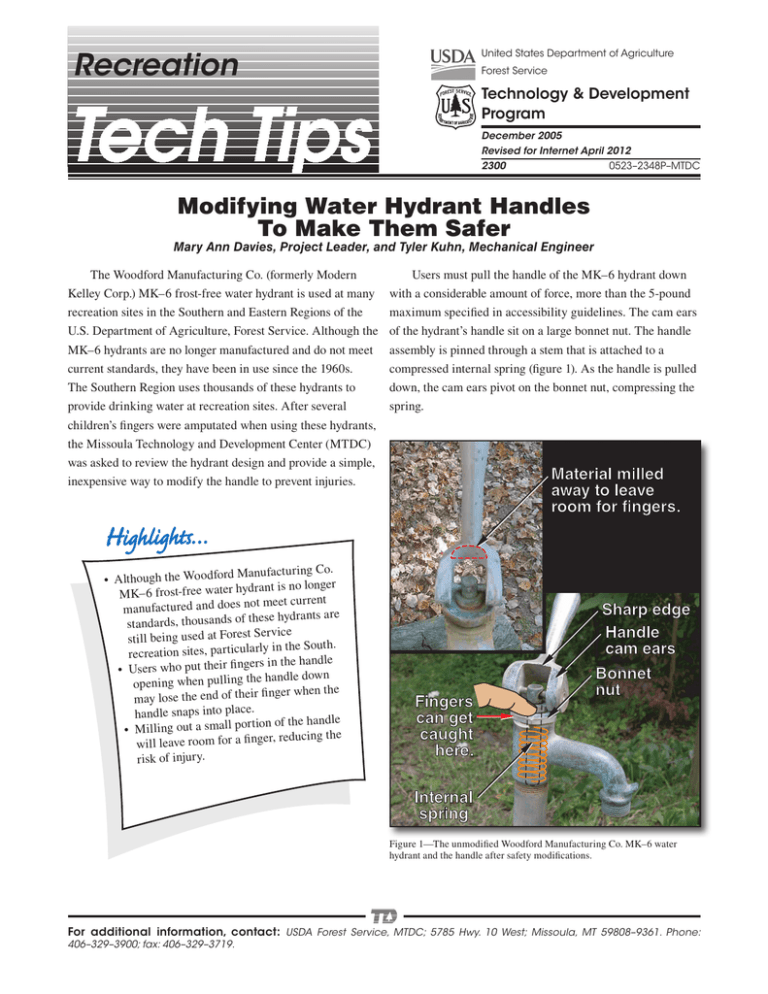
Recreation United States Department of Agriculture Forest Service Technology & Development Program December 2005 Revised for Internet April 2012 2300 0523–2348P–MTDC Modifying Water Hydrant Handles To Make Them Safer Mary Ann Davies, Project Leader, and Tyler Kuhn, Mechanical Engineer The Woodford Manufacturing Co. (formerly Modern Users must pull the handle of the MK–6 hydrant down Kelley Corp.) MK–6 frost-free water hydrant is used at many with a considerable amount of force, more than the 5-pound recreation sites in the Southern and Eastern Regions of the maximum specified in accessibility guidelines. The cam ears U.S. Department of Agriculture, Forest Service. Although the of the hydrant’s handle sit on a large bonnet nut. The handle MK–6 hydrants are no longer manufactured and do not meet current standards, they have been in use since the 1960s. The Southern Region uses thousands of these hydrants to provide drinking water at recreation sites. After several children’s fingers were amputated when using these hydrants, the Missoula Technology and Development Center (MTDC) was asked to review the hydrant design and provide a simple, inexpensive way to modify the handle to prevent injuries. Manufacturing Co. • Although the Woodford rant is no longer MK–6 frost-free water hyd t meet cur rent manufactured and does no se hydrants are standards, thousands of the rvice Se still being used at Forest in the South. ly recreation sites, particular the handle in s ger • Users who put their fin dle down han opening when pulling the when the ger fin may lose the end of their handle snaps into place. tion of the handle • Milling out a small por , reducing the will leave room for a finger risk of injury. assembly is pinned through a stem that is attached to a compressed internal spring (figure 1). As the handle is pulled down, the cam ears pivot on the bonnet nut, compressing the spring. Material milled away to leave room for fingers. Sharp edge Handle cam ears Fingers can get caught here. Bonnet nut Internal spring Figure 1—The unmodified Woodford Manufacturing Co. MK–6 water hydrant and the handle after safety modifications. For additional information, contact: USDA Forest Service, MTDC; 5785 Hwy. 10 West; Missoula, MT 59808–9361. Phone: 406–329–3900; fax: 406–329–3719. 1 Persons who aren’t strong enough to pull the handle all the way down may place their fingers inside the handle opening to gain leverage. When the handle is nearly down, the opening’s sharp edge snaps into place against the bonnet nut (figure 2) with enough force to amputate the end of a finger. Fingers can get caught here. tried, but the camming action of the handle ears pulled the boots out of place every time. Another solution tried in the field was to dull the handle’s sharp edge where it contacts the bonnet nut. This method does not eliminate the risk of injury and is not recommended. A better short-term solution is to modify the handle by milling away material, creating an opening between the handle and nut. The machine shop at MTDC used a milling machine to do so (figure 4). If users place their fingers on the nut when they pull the modified handle down, the opening leaves space for their fingers (figure 5). Figure 6a shows the difference between the original handle and the modified handle (figure 6b). Figure 2—The MK–6 hydrant handle showing where fingers can get caught. Finding a Solution The first attempt to solve the problem enclosed the bottom portion of the handle and the bonnet nut with the universal boot from an automobile’s constant-velocity joint (figure 3). The idea was to prevent users from placing their fingers in the handle opening. The boot was placed over the bonnet nut and pivoting handle ears and secured on the top and bottom with nylon tie clamps. Many sizes and shapes of boots were Figure 4—A milling machine was used to cut metal from the handle of the MK–6 hydrant. Figure 5—The handle of the modified MK–6 hydrant has room for a finger. Figure 3—A universal boot for an automotive constant-velocity (CV) joint. 2 Hydrant handle 55 degrees Figure 6a—The original MK–6 hydrant. Figure 7—Use a protractor to align the centerline of the handle at a 55-degree angle. Figure 6b—The MK–6 hydrant with the modified handle. Modifying the Hydrant Handle • • • • • Use a milling machine with a 1 1 ⁄16 -inch end mill. Place the hydrant handle in a vise. Use a protractor to align the centerline of the handle at a 55-degree angle (figure 7) relative to the top of the vise. Mill out material to the edge of the handle collar (figure 8). Mill both sides of the handle. Figure 8—Mill material to the edge of the handle collar. Conclusions Milling out the handle core at a 55-degree angle leaves enough metal to maintain the structural integrity of the handle (figure 9). Several milled handles that were used in Forest Service campgrounds during the summer of 2005 did not show signs of fatigue. 3 Sharp edge Original handle. Filed edge Milled edge Modified milled handle works as a short-term solution. Interim solution that is not recommended. MK-6 handles Figure 9—The original MK–6 handle with a sharp edge (left), a filed edge (middle), and the edge after milling (right), the recommended solution. A machinist could modify about four hydrant handles an hour using a vise and protractor to establish the angle. A positioning fixture could increase the production rate to about 20 handles per hour. At Forest Service recreation sites, all water hydrants and hose bibs require a backflow prevention device or another means to prevent a garden hose or other backflow hazard from being connected to the hydrant. All hydrants need to be outfitted with a double check valve backflow-prevention device approved in accordance with the American Society of Sanitary Engineers Standard 1052. Woodford Manufacturing Co. has designed an add-on, backflow-prevention device, Model 37HD1, for MK–6 hydrants. Routine maintenance needs to be performed to ensure that hydrants operate properly and do not leak. Woodford Manufacturing Co. distributes the U150M and U200M hydrant models that replaced the MK–6 design. Replacement parts, such as O-rings and washers, are available for the MK–6 hydrants. See the Woodford Manufacturing Co. U150M and U200M model cut sheet (figure 10) for a parts list. Additional troubleshooting and maintenance information 4 can be found at: http://www.woodfordmfg.com/Woodford /Yard_Hydrant_Pages/techUtil.htm. For a long-term solution, replacement hydrants are available that meet accessibility guidelines. These hydrants operate with 5 pounds of force, meet Federal drinking water standards, and will not freeze (are frost free). Companies manufacturing hydrants that meet these criteria are Hoeptner Products, Most Dependable Fountains, Murdock (model BFH–M92_FS), and Woodford Manufacturing Co. (Model S4H). The tech tip, Sanitary, Frost Free, Accessible Hydrants (9923–1304–SDTDC) has further information about accessible hydrants manufactured by Murdock and Woodford Manufacturing Co.: http://www.fs.fed.us/eng/pubs/pdf/9923 1304.pdf. Forest Service and Bureau of Land Management employees can find information on accessible hydrants manufactured by Hoeptner Products and Most Dependable Fountains, as well as other information on safe drinking water, at the Forest Service’s Washington Office Engineering internal Web site: http://fsweb.wo.fs.fed.us/eng/programs/water /documents/frz_ flow.htm. Figure 10—Refer to the parts list when maintaining the MK–6 hydrant. 5 About the Authors Mary Ann Davies received a bachelor’s degree in mechanical engineering with a minor in industrial and management engineering from Montana State University in 1988. She worked in the Pacific Northwest Region as a facility engineer and as a tramway engineer. She has worked in fire management as a crewmember and as a crewboss. She worked for 5 years at the Rocky Mountain Research Station’s Fire Sciences Laboratory in the fire chemistry and fire behavior groups before coming to MTDC in 1999. Tyler Kuhn is a mechanical engineering technician. He began working at MTDC as an intern in 2000. He received a bachelor’s degree in mechanical engineering from Montana State University in 2001 and has worked as a mechanical engineering technician since then. Library Card Davies, Mary Ann; Kuhn, Tyler. 2005. Modifying water hydrant handles to make them safer. Tech Tip 0523–2348– MTDC. Missoula, MT: U.S. Department of Agriculture Forest Service, Missoula Technology and Development Center. 6 p. Describes modifications to make the handle of the Woodford MK–6 frost-free hydrant safer to use. Although this hydrant is no longer manufactured, it is used extensively at Forest Service recreation sites in the Southern United States. The hydrant’s handle closes with enough force to amputate the end of a finger. Metal can be milled away from the handle to leave enough room for a user’s finger, preventing injuries. Keywords: amputations, drinking water, safety Single copies of this document may be ordered from: USDA Forest Service, MTDC 5785 Hwy. 10 West Missoula, MT 59808–9361 Phone: 406–329–3978 Fax: 406–329–3719 Email: wo_mtdc_pubs@fs.fed.us Electronic copies of MTDC’s documents are available on the Internet at: http://www.fs.fed.us/eng/pubs/ Forest Service and Bureau of Land Management employees can search MTDC’s documents, videos, and CDs on their internal computer networks at: http://fsweb.mtdc.wo.fs.fed.us/search/ For additional technical information, contact MTDC. Phone: 406–329–3900 The Forest Service, United States Department of Agriculture (USDA), has developed this information for the guidance of its employees, its contractors, and its cooperating Federal and State agencies and is not responsible for the interpretation or use of this information by anyone except its own employees. The use of trade, firm, or corporation names in this document is for the information and convenience of the reader and does not constitute an endorsement by the Department of any product or service to the exclusion of others that may be suitable. The U.S. Department of Agriculture (USDA) prohibits discrimination in all its programs and activities on the basis of race, color, national origin, age, disability, and where applicable, sex, marital status, familial status, parental status, religion, sexual orientation, genetic information, political beliefs, reprisal, or because all or part of an individual’s income is derived from any public assistance program. (Not all prohibited bases apply to all programs.) Persons with disabilities who require alternative means for communication of program information (Braille, large print, audiotape, etc.) should contact USDA’s TARGET Center at (202) 720-2600 (voice and TDD). To file a complaint of discrimination, write to USDA, Director, Office of Civil Rights, 1400 Independence Avenue, S.W., Washington, D.C. 20250-9410, or call (800) 795-3272 (voice) or (202) 720-6382 (TDD). USDA is an equal opportunity provider and employer. 6
